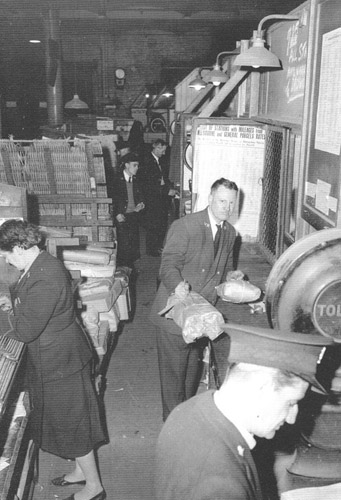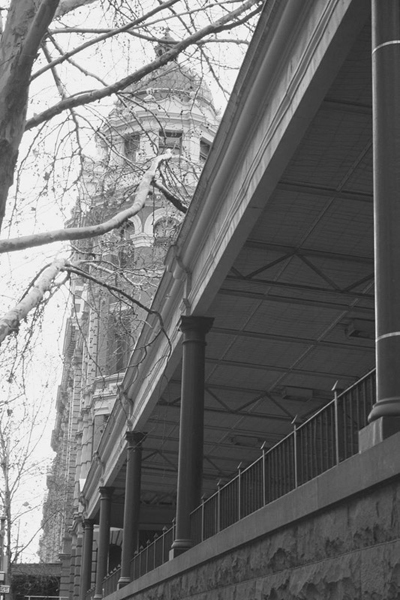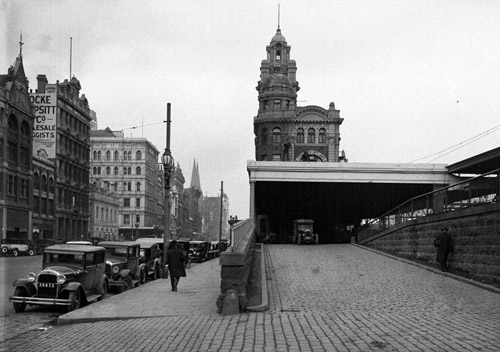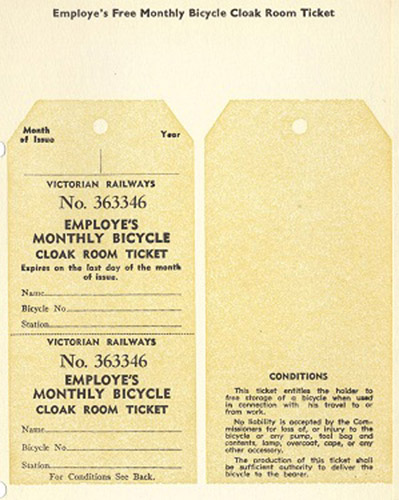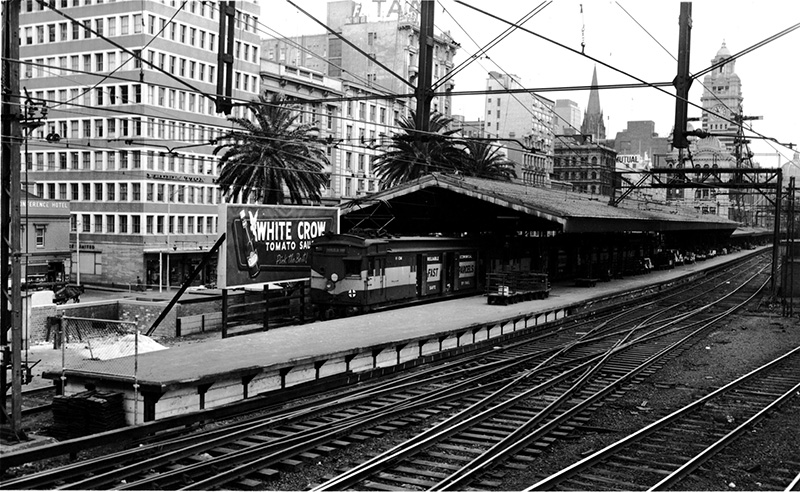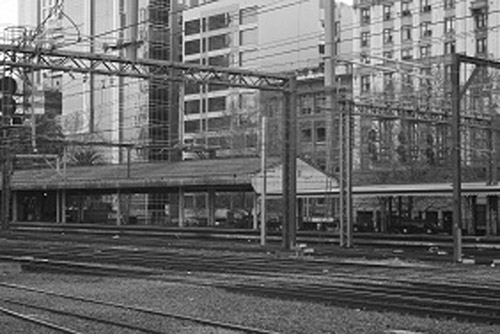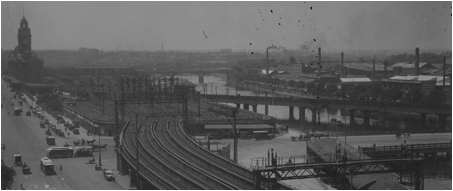PARCELS & MILK DOCK: STORIES
Working in the Parcels Office
Disused Parcels Office - always busy
|
No one wanted to work in the parcels office because it was so busy. I used to drive a yellow motor pulling the parcel trolleys. The parcels would be loaded into the freight lift that was located just beside the Elizabeth Street subway stairs and would be unloaded in the subway. The trolleys could then be taken to any of the platforms via the ramps. The destination stations for the freight was marked on platform 1 outside the parcels office and you can still see the markings there. |
The Paper Trains
Parcels verandah and the end of the station building
|
Up until the late 1970s or early 80s, goods trains conveying newspapers to country Victoria used to depart from Melbourne in the wee small hours of the morning, from Monday to Saturday. These were known as the paper trains. One of the perks of being part of the crew on a paper train was a free newspaper. When I started work on the footplate in late 1964, there were four paper trains that used to load their papers at Flinders St. There was the Traralgon paper train, which ran express to Warragul and then put out papers at all stations to Traralgon. This train loaded papers on No 1 platform and was always run by Warragul crews. During the 1970s, this train became an express goods train timetabled to run at 60MPH. The Warragul paper train loaded at platform 6 and discharged papers from Hallam to Warragul. Both these trains were hauled by L class electric locos. The Korumburra paper train carried papers for Cranbourne and all stations beyond including Dalmore, which was a tiny station between Tooradin and Koo-Wee-Rup. This was an unlit platform, about ten feet long, out in the middle of nowhere. We used to slow down to about ten miles per hour as we passed through and the guard would throw out a bundle of papers. I often wonder, particularly on foggy winter mornings, how many times the papers ended up in the swamp rather than on the platform. This train also loaded papers on platform 6. The fourth paper train that loaded at Flinders St was the Lilydale paper train. This train loaded papers on platform 2 and took papers for Ringwood and all stations to Lilydale. This was a rather oddball train in as much as it was the only suburban goods train that carried newspapers. It was run by South Dynon crews about three days a week and on those days was hauled by a T or Y class loco and on the other days it was crewed by the ERD (electric running depot) and hauled by an E class, commonly referred to as “Black locos”. This train ceased running about 1967 and was replaced by a parcels coach. |
The Country Platform
Heritage Listed Parcels & Milk Dock entrance
|
The Gippsland line to Sale was built in the 1870s. Initially all Gippsland passenger trains terminated at Princes Bridge Station (where Federation Square now is) before there was a connection under Swanston Street to Flinders Street Station. The railway system on the east side of Swanston Street was the initiative of several different private railway companies whereas the rail system on the west side had been established by the Melbourne & Hobson’s Bay Railway Company in 1854. Around 1908 a connection between the two stations was begun and when completed, all Gippsland passenger trains arrived or departed from No.1 Platform. By1890, the line from Crib Point on Western Port Bay had been established as had several important branch lines off the Gippsland line including the loop from Traralgon through Maffra to Stratford. The Gippsland line from Moe had subsequently been extended to Bairnsdale. By 1900 the line that had ended at Tooradin had been extended through South Gippsland to service Korumburra through to Port Albert. By 1910, a line from Nyora to Wonthaggi had been opened. No.1 Platform was the longest in the southern hemisphere for many decades (at about 700m) and one of the longest in the world. It was usually referred to in three sections as No.1 East, Centre and West with the western end used for loading and unloading parcels, including those from the suburban parcels vans. Until the early 1970s, all Gippsland trains arrived or departed from Platform 1 at Flinders Street. The Gippsland trains unloaded and loaded their parcels and mail at No.1 west. Every evening at 6pm except Sundays, the Yarram train would stand at No. 1 East awaiting departure at 6.12pm. The Bairnsdale train was docked at No.1 centre awaiting its departure two minutes later at 6.14pm. Thanks to Barry Sykes for his input
|
Cloak Facilities
Cloak ticket for a bicycle
|
It was possible to cloak almost anything at the station. There was a significant amount of space available as cloakrooms. The Herald & Weekly Times rented space in the cloak room at the back of the booking offices under the dome to store the news stand which was used at the bottom of the stairs. Cloak facilities were phased out as the Parcel Service diminished. Lockers were available for temporary storage in the large room used for Lost Property now occupied by the VRI along Flinders Street. |
The Parcels Van in the Milk Dock
|
Even in the slacker periods, 4,500 parcels of general merchandise are handled here (in the parcels office) daily – some customers sending over 200 at a time. In addition, hundreds of parcels of papers and magazines are dispatched. Revenue is £13,000 a month. |
The Milk Dock
The original asbestos cement roof of the Milk Dock now removed
|
The Milk Dock was part of the western end of Platform 1 and was originally built to deal with freight – in particular, milk and parcels. The platform is particularly wide at the western end and had track through it which terminated before the platform narrowing. This was generally referred to as the Milk Dock. Trains could be shunted into this track to have their freight unloaded. The shed that now covers the Milk Dock had its roofing removed several years ago. Its roofing was of corrugated asbestos-cement known as ‘Durabestos’ which was produced by the Wunderlich Company most probably in their Sunshine factory established in 1926. This product had only recently been developed. The Milk Dock shed was likely to have been constructed after this date. The following photo shows the large roofing of the Parcels area and no evidence of any shed on the Milk Dock itself. The track running into the wide platform with the buffer stop is evident. The platform has been extended since this photo was taken. The whitish objects on the dock could be milk churns along with general freight.
From The Victorian Railways Magazine, May 1926 The bulk of south-eastern Victoria’s milk comes up to Melbourne on the 9.36am from Nyora every morning. Twenty-five cans are transferred from the 7.20am from State Mine, and at Koo-Wee-Rup, in addition to a local supply of about 30, 100 cans or thereabouts from Strezlecki line stations are awaiting the arrival of the Nyora train. The advent of refrigeration brought great changes to the dairy industry. The need to transport milk by rail was no longer necessary as the convenience of refrigerated vans increased which could provide door to door service. Thanks to Barry Sykes for his input |

